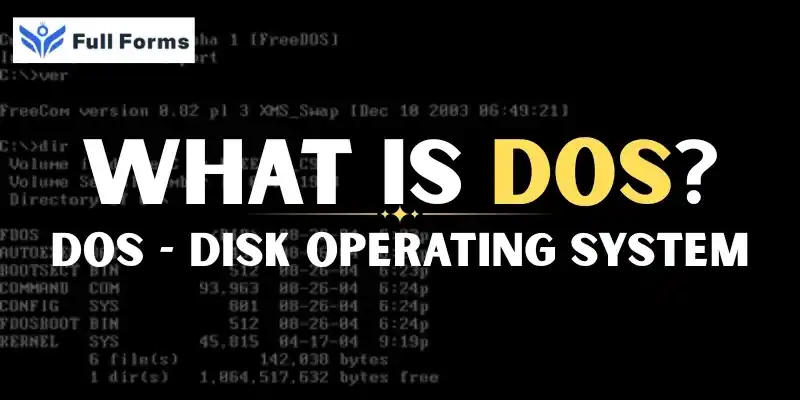Disk Operating System
(DOS)

Description
What is DOS?
A Disk Operating System, commonly known as DOS, is a type of operating system that manages files and programs on a computer’s hard drive or floppy disk. This system was very popular in the early days of personal computers, especially during the 1980s and 1990s. Even today, understanding DOS gives us a look into the history of computers and how they work at a basic level.
History of DOS
DOS was first developed in the early 1980s, at a time when computers were becoming more popular in homes and offices. The most famous version is MS-DOS (Microsoft Disk Operating System), created by Microsoft. IBM PCs, one of the first widely used personal computers, used a version of DOS called PC-DOS.
Before DOS, computers often used punch cards or very basic operating systems. DOS made it much easier for regular people to use computers because it allowed them to save and manage files directly on disks.
How DOS Works
When you turn on a computer with DOS, the operating system loads from the disk into the computer’s memory. From there, you see the command prompt, which looks like C:>. This means the computer is ready to receive commands.
Some common DOS commands include:
- DIR: Lists all files and folders in the current directory.
- COPY: Copies files from one place to another.
- DEL: Deletes files.
- CD: Changes the current directory.
These commands may seem simple, but they allowed users to do everything from editing documents to running games and software.
Importance of DOS
DOS played a crucial role in the development of personal computers. It allowed people who were not computer experts to operate a computer and manage their files. Software developers also built many programs and games for DOS, making it the foundation for early computing.
MS-DOS, in particular, was the first operating system used by Microsoft Windows. In the early versions of Windows, DOS was still running in the background. Even as Windows became more advanced, many users continued to use DOS for certain tasks.
Limitations of DOS
Although DOS was very important, it had its limitations. DOS can only run one program at a time. It does not have the ability to multitask like modern operating systems. Also, everything must be done using text commands, which can be difficult for beginners.
Another limitation is its support for hardware. DOS was designed for older computers, so it does not work well with new devices or technologies. For example, it cannot use large amounts of memory or newer types of storage devices.
DOS Today
While modern computers no longer use DOS as their main operating system, it still has some uses today. Some people use DOS to run old games or software that only work in a DOS environment. There are also DOS emulators, which allow you to run DOS programs on new computers.
In addition, learning about DOS can help people understand how computers work behind the scenes. Many basic ideas in DOS, like file management and command-line interfaces, are still used in modern systems like Windows, macOS, and Linux.
Conclusion
Disk Operating System, or DOS, was a key part of computer history. It helped make computers easier to use and allowed people to manage files on disks with simple commands. Although it has been replaced by more advanced systems, DOS remains an important part of how computers developed. Understanding DOS gives us a clear view of how far technology has come and helps us appreciate the tools we use today.
